Be Thankful for Fitness
“Working out is a privilege”
I took a cycling class this morning. It wasn’t a typical spin class offered at the gym, rather a sweat-inducing, heart-pounding, muscle-fatiguing class at the local Cyclebar studio.
During one particularly challenging part of the class, Jodi, our instructor, shouted out something that I love – the quote you read at the beginning of this blog: “Working out is a privilege.”
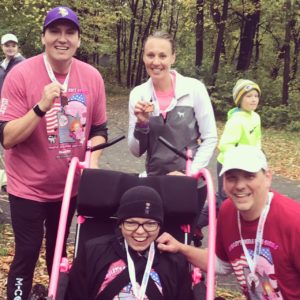
Ainsley’s Angels always reminds me how fortunate I am to be able to run.
It really is, isn’t it? Too many times, many look at working out as something we have to do. But it’s something we get to do.
Sure, it can be tough. Many workouts are challenging. And some are downright exhausting. But every workout is an opportunity to treat ourselves to numerous health benefits. A chance to make ourselves feel better than if we didn’t do it. Something many of us take for granted that we have the ability to do. It really is a privilege.
Especially this time of year when we’re giving thanks and counting our blessings, while also rushing around to holiday parties, baking for cookie exchanges, and squeezing in all the shopping, let’s not forget the ability of our bodies and minds to be at their best, and the opportunity we have to get them there.
What are you thankful for this year? Comment or tweet me, @LindsayIRL. Share your wellness gratitude moments on Twitter and Instagram with the hasthtag #wellirl.
How to Stay Safe Running in the Dark
“Hello darkness, my old friend”
Last week’s blog was the unofficial start of winter running, and I was excited to share tips to help all brave the temps and enjoy the outdoor miles during this beautiful season.
This week brings more on outdoor running during another notable time of year, though I bring it to you not as enthusiastically. It’s the only drawback that comes with running outside this time of year – darkness.

Don’t worry, Burton – we’ll be safe out there
The early morning daylight is a distant August memory and the evening daylight has been dwindling, with it all but gone now when most of us leave work for the day. If you’re like me and enjoy a post-work run outside or if you’re an early riser who hits the pavement, you’re going to deal with darkness.
While enjoyable and safe, dark running comes with a slew to strategies to ensure both of those benefits are met. Here are a few things to consider to stay happy and healthy during the season of darkness.
Ditch the Headphones
I’m a big fan of running without headphones for focused, peaceful, and mindful outdoor running. When it’s dark out and you need to be more aware of your surroundings, it’s an even stronger case for leaving the iPod at home.
If you need your tunes or podcast while you stride, at least turn down the volume so you’re not totally zoned out from the world.
Invest in a Vest
It’s a good idea to wear bright-colored clothing when running in the dark. Taking it a step further, a bright, reflective vest is a great addition to your running gear this time of year. The one I have it super lightweight so I barely even notice it – though I take comfort in knowing drivers notice it.

A small piece of gear that offers a big benefit
Plan Ahead
Mapping out your route ahead of time is smart, especially so you can include paths and locations that are well-lit and safe – and avoid areas that aren’t.
Bonus if you can leave the route on your computer for your roommate, spouse, or parent to know where you are and how far you’re going.
Bring a Phone
In addition to skipping headphones, my phone is typically something I leave at home during a run. It’s the one time in the day I feel like it’s okay to unplug and not be available. But there’s a good argument for having it on dark runs.
In the event something goes horribly wrong during the run – you roll an ankle on uneven ground, trip over something you don’t see, or encounter a shady individual – having a phone can be a literal lifesaver.
Don’t Forget Your Furry Friend
While it’s great to have your safety as first priority, don’t forget about your running buddy (if you have one).
Burton’s regular running leash is reflective so it’s great for those semi-dark or dusk runs. When it gets really dark or if I know we’ll be running on a path where we may encounter others, I have a little light that I can attach to the leash to make sure people and pets are aware of us.
What else do you do to stay safe and enjoy outdoor running this time of year? Comment or tweet me, @LindsayIRL. Share your dark running experiences on Twitter and Instagram too using hashtag #wellirl.
Oh Yeah, I’m Running Chicago Marathon Sunday
“Ch-ch-ch-ch-changes”
As I write this, I’m getting organized to head to Chicago. With my parents. To visit my brother and his family. Oh, and to run the 40th Chicago Marathon. That’s happening too.
It’s crazy, I haven’t wrapped my mind around the fact I’m going to run a marathon Sunday. For the first time in my marathon running life, it hasn’t received the bulk of my focus and attention these past few weeks. It’s not at center stage.

Me, dorking out at the Grandma’s finish line in Duluth – and I wasn’t even running.
This isn’t totally shocking, even for me, as this marathon has also been the strangest training period for me. In addition to my mental state being off, I’ve admittedly focused less on my actual training than previous marathons. Mileage has been lower, nutrition not strict and tracked, and cross-training and other details that are usually crucial to me during marathon prep haven’t been.
What gives? You’d think I wasn’t excited to run Chicago Marathon for the first time. A race I’ve wanted to run for a few years now. A race I’ve heard nothing but wonderful things about. A race several of my family members are attending to watch and cheer.
Aside from some significant life changes that have come the past several weeks (which have been good, no worries there), I can’t put my finger on this one.
I know this training season has been one of the hardest I can remember, primarily due to the fact most of it occurred during the summer (a first for me). I wonder if the fall race timing is throwing me off a bit too, as I’ve never run a marathon this time of year? A big part of why I think this hasn’t sunk in yet is I’m still in denial about my brother not being able to run with me.
After training hard and jumping through a few hoops to get into the race, which would have been his first marathon, he found out last week a stress fracture is going to prevent him from running. I’m selfishly bummed to not have him by my side, taking a 26.2-mile stroll through the city he calls home, but I’m especially bummed for him having to miss out. While he probably has major FOMO, I’m over here all blasé to the fact I get to participate in this iconic race. Seriously, Lindsay – what gives?!
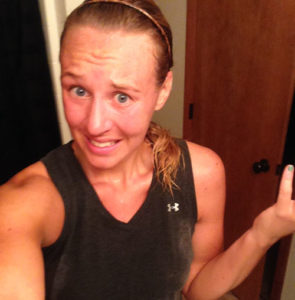
This face sums up my typical pre-marathon mood.Yes, this is what I want.
Regardless of why I’m so off on this one, I think once I get to the city, attend the expo, pick up my packet and all those goodies, it will start to sink in and the joy, excitement, and nerves will follow – I hope anyway! The pre-race anticipation is one of my favorite parts of marathon training, and I want those butterflies and excitement. It’s funny, I used to wonder if there would come a time that I wouldn’t get so neurotic and edgy before a marathon. Now that time appears to have arrived and I’m not happy about this change of mood. Still, change can be good so perhaps I’ll get into the marathon spirit and have a great race!
Shoutout to all running Chicago Marathon Sunday. Those of you I follow on social media, I’ll be watching for your pics and moments throughout the weekend. Use hashtag #wellirl so I can easily find and retweet you.
Have you ever had an off reaction to an upcoming race? Were you uncharacteristically cool and aloof like me – or the opposite, and ball of nerves instead of your usual, cool self? Comment or tweet me @LindsayIRL.
7 Days, 7 Ways to Prepare to Run a Marathon
“It seems I’m spending so much time…waiting…”
I can’t believe I’m saying this but it’s time to run the Chicago Marathon! My fellow runner friends, the countdown is on.
I’ve said it before and it’s still true, the week before a race is always tough. All the weeks, months, even years of hard training, come down to one day. Actually, one morning. Actually, just a few hours. It’s a lot of pressure mixed with nerves and anticipation – it’s so close but you’re still counting down, waiting for the big day.

Marathon week is a lot like standing on the edge of Chicago’s Willis Tower
Whether your emotions are getting the best of you in these last few days leading up to the race, or it’s your first race and you need a little help preparing, I’ve put together a week’s worth of pre-race to-dos. Yes, this is partially to distract and keep you busy but a lot of this stuff is really useful and you’ll be glad you did it.
Monday – Food Prep
Today, do your shopping and food prep. Not only do you want to stock up on all the foods you’re familiar with, you know sit well with you, and give you energy, you might want to make selections based on the weather forecast. For example, if it’s going to be hot and humid on race day, buy a few extra salty food options to help retain water and ward off race-day dehydration. And a couple extra bottles of Gatorade, always a good idea.
If you’re traveling to Chicago like me, be sure to plan ahead for snacks and foods you can bring with you.
Tuesday – Toenails
Today, trim your toenails. Not too short but a good trim. Trust me. Do it
.
Wednesday – Check And Plan
Today, go online and review all the location details of the race so you have a clear idea of where everything is happening. This includes where to pick up your packet, where the start and finish lines are, and where to park.
A few other things you may want to do is figure out the best route to get to the course and alternate routes to account for heavy traffic on major roads. Find out if and where the bathrooms will be on race day. Also, find out if there’s a bag drop or if you need to leave stuff in your car (that will determine what you bring with to the race). Lastly, you can also check out the course map – or don’t if you like to be surprised.
Thursday – Shopping
Today, go buy stuff like Band-aids, BodyGlide, sunscreen, gum, anything you might need for race day. By now, you should have a good idea of what the weather is going to be like so, if need be, now is also your last chance to shop for new clothes. Why today? If you do buy something new, you have the opportunity to try it out on one of your last runs. You never know how things will move with you, where they’ll rub, or what could be a major chafing hazard, and you don’t want to be stuck with that for 26.2.
One thing I wouldn’t recommend buying this close to race day: shoes. But, like I always say, different strokes for different folks. One year, my friend Jason bought a new pair of shoes the day before we ran a half marathon. He wore them for the race and – claims – he had no discomfort at all. So if you’re “that” guy or gal, go ahead and sport those new kicks straight out the box.
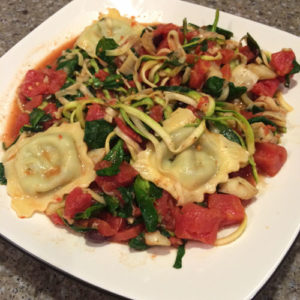
It sounds cliche but pasta, zucchini noodles, & veggies is still a pre-marathon fave
Friday – The Big Meal
Today, eat your biggest dinner. What that dinner is, that’s your call. Some people carb-load. Others believe in fat-loading. Some don’t care what they eat at all. But it’s still usually a good idea to have your biggest meal today vs. tomorrow. That gives your stomach time to settle and fully digest so you don’t feel heavy on race day.
Saturday – Stuff And Rest
Today, organize your stuff, then rest. Pick up your race packet. If packet pickup is at the same location as the race start and/or end, bonus, as you get a chance to navigate the area before the chaos of race morning.
Before you head to bed, set your alarms and lay out everything you need for the next morning. In addition to your bib, your watch, outfit, chapstick – even your shoes. Have it all ready to go so you don’t have to think about anything tomorrow morning except getting to the start line. And speaking of bed, don’t worry if you can’t sleep. With all the nerves, excitement and anticipation, most runners don’t sleep well the night before a race.
Sunday – Kick Some Ass
Enjoy the run, thank volunteers and spectators, and be sure to celebrate after. I’m counting on my fam, the locals, to take us to the best pizza place for a post-run meal.
Good luck, Chicago Marathon runners! If you have other pre-race questions, or some good tips of your own to get through pre-race week, comment below or tweet me @LindsayIRL. Please share your Chicago Marathon photos on Instagram an Twitter with hasthtag #wellirl.
A Family Outing at the Chicago Marathon
“Big brothers – the only guys who will pick on you, yet beat up anyone else who tries”
Earlier this week, as I was working on an idea for a new blog, it occurred to me I run Chicago Marathon in just two weeks and I’ve barely blogged about it. I’m usually good for at least a few pre-marathon blogs.
Why do I have seemingly no love for Chicago? Maybe because it has been really difficult for me to train in the summer? Perhaps because I’ve been fighting more aches, pains, and soreness than ever before? Probably because training for this marathon has been a less-than-enjoyable experience and I like to keep it positive in this space.
Speaking of positive, I do have one super-awesome story I haven’t shared yet about Chicago Marathon – it’s going to be quite the family affair.

From fancy pants then to running gear in a couple weeks
This will be the first marathon for my oldest bro who lives in Chicago. He got into running and triathlons just a couple years ago and is hooked (must ‘run’ in the family – see what I did there?!). What’s even cooler is he has a family and big-time important job where he travels the world frequently, yet still makes time to train and race in other events.
When he and his family were back for early Christmas last year, we somehow started talking about Chicago Marathon and how cool it would be to run it together. In spite of the horrified looks from his wife and two daughters, we giddily signed up for the lottery and hoped for the best.
Fast-forward to today, we may both be struggling a little bit with injuries and issues, but we’re still excited to line up and finish together. How cool, right?!
Not only will my sister-in-law and two rad nieces be there to cheer us on, my dad and stepmom are making the trip to Chi-town too. If you follow my blog, you know my mom has only missed one full marathon in my life and has been there with my stepdad for several other races. But my dad and stepmom have never been to a race so they’ll be there to see Terry and me – and all our marathon phases: excited and smiling at the beginning, still happy through most of the miles, pained and angry in the 20s, then exhausted yet elated at the finish. Oh, how fun for them!
So there it is, a great story about Chicago Marathon that’s long overdue on the blog. Big shoutout to my big bro and I’m kind of nerdily honored to be there with him for his first marathon. Definitely something that has helped me gut through some of those extra-tough training miles.
Who else is running Chicago Marathon? Those of you who have run in the past, what was your favorite part or something on the course we should look forward to? Comment or tweet me, @LindsayIRL. Share your run brags on Twitter and Instagram too using hashtag #wellirl.
Make More Room for Joy
“Getting what you want starts with getting rid of what you don’t”
Having football back is the best, am I right? Now that we’re a couple weeks into the college and pro seasons, it feels official. And I love it.
Last year I did something that made me enjoy Sunday football even more; something I hadn’t done in at least 10 years. Last year, I quit playing fantasy football.

Sunday football is way better chillin with these two
Don’t get me wrong, fantasy football can be a blast. But it can also be miserable, and too many times, it ruined my Sunday Funday enjoyment of watching the pros toss around the good ole pigskin. More often than not, fantasy football was not bringing me joy. So I started to wonder why did I continue to spend time doing it?
This made me think about a seminar I attended a few months back. The overall theme was tips for making the most of the hours in your day. And one of the biggest takeaways I learned was about eliminating the things that don’t bring you joy.
How many things do we do because we feel we should? This is especially true for women; we feel obligated to say “yes” to everything, from committees to excessive volunteer activities to creating perfect Pinterest – everything.
Wellness is all about balance, taking time for everything that must get done and making time for ourselves. Eliminating the excess stuff that doesn’t make us happy or, as the speaker said, bring us joy, can free up enough time for the things we really want to do, and the ones that are good for our overall wellness.
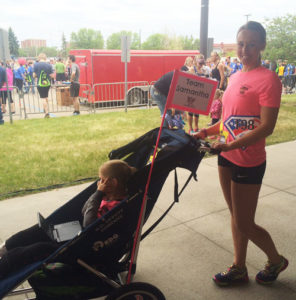
Running brings me joy so I make time for it
From stressing over roster moves to jumping off the treadmill, grabbing my phone out of the locker, and making a last-minute roster change after finding out my top RB is sitting out, there’s plenty of upside to my decision to drop the joy-sucking fantasy football shenanigans from my life.
Is there something in your life that you do because you should, not because it brings you joy? What would you have more time for by eliminating the excess? Comment or tweet me, @LindsayIRL. Share your workout brags on Twitter and Instagram too using hashtag #wellirl.
Eat Healthy, Eat Happy, Eat Inclusively
“Inclusion isn’t just the right thing to do, it’s the smart thing to do”
Have you ever done Strengths Finder? In a non-certified nutshell, it’s a program that uses a series of questions to gauge a person’s top “themes” aka, areas of greatest strength. Companies often have employees go through the program to better understand where they shine, help them work better as teams, and help managers better manage based on people’s unique strengths.

Life is the best when everyone is included
In my top three strengths is the theme, Includer. Again, in an “I’m-not-certified-so-I-only-know-the-basics” nutshell, it means when I’m in a group setting, I proactively make an effort to ensure everyone feels included. This theme is one I definitely feel fits me. I always hated feeling left out of anything when I was younger so it’s important to me that no one else ever feels like they’re not being included.
I realized this inclusive trait extends to other areas of my life – one in particular, eating. Not shocking to anyone who reads the blog or follows my social accounts, I love food. More than that, I’m a fan of inclusive diets vs. those that deem you can’t eat certain foods.
I know, I know – this idea of inclusive eating probably sounds really bizarre coming from someone who voluntarily excludes a major group of foods from her daily diet. Yes, I’m a vegetarian. No, I don’t exclude meat because I think it’s bad or I shouldn’t eat it. I simply don’t like it; never really have. I wish I did though; I would totally mooch off my husband’s stellar meal prepping skills.
Anyway, back to diets. I think most people have tried a diet or two in their lifetime that comes with rules of certain foods you can’t eat. As in life, here’s why I feel an inclusive approach to eating is best.
1. Variety is the Spice of Life
Unless you’re allergic, intolerant, or simply don’t like something, there’s no reason you should have to exclude anything from your diet. Opening yourself up to all possibilities keeps things interesting, plus, you might find some new, healthy food combos that you really enjoy.
And, not only does restrictive eating get mundane, depending on how restrictive it is, it might be really hard to maintain IRL. Raw veggies and meat only might sound like a great idea in theory but it’s also really tough to exclude all the other foods – both from a convenience and willpower standpoint.
2. Nutrition
Speaking of high-restrictive, omitting certain foods could leave you lacking in nutrients. Most restrictive diets do just that – restrict. Whether dairy, carbs, gluten (which, p.s. is not a diet but too many people treat it like one), or fruit is off-limits, the body ends up missing out on the natural goodness found in those foods.
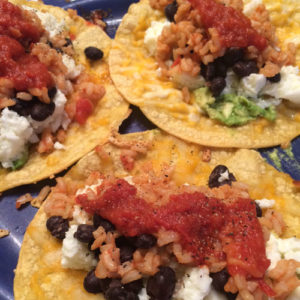
Not a perfect meal but lots of good, tasty stuff in here
Supplements are an option but typically the body doesn’t absorb the nutrients as well as it does if it were actual food. As someone who has tried really hard to make up for lack of protein with powders, bars, even beans and legumes, trust me, I know – it’s not quite the same as the protein power that comes from animal meat. Sigh.
3. Screw Deprivation
Ice cream. Skittles. Cheetos. While one could argue there is zero nutritional value to these foods and they should therefore be excluded from a healthy diet, I disagree. There’s nothing wrong with enjoying a treat every now and then – even if it is a zero-nutrition, sugar-filled, empty-calorie donut. Mmmm, donuts. If you want the donut, have it! Then get over it and get back to the good stuff at your next meals. Deprive yourself too long and it could be a quick train ride to binge-city.
Plus, by labeling some foods as “forbidden” the desire to eat them might grow and you’ll feel awful about yourself when you indulge when, really, it’s okay. Again, move on and eat something better at your next meal.
4. Being Social
Take it from a vegetarian – when your diet doesn’t include a common, popular type of food, social settings where food is involved can be tough to navigate. Many times, my “dinner” has consisted of a hotdog bun with cheese because there was nothing else for me to eat. The upside, I wasn’t staring at the hotdogs and hamburgers, wishing I could have one.
A restrictive diet can be tough in social situations as much as personal ones. Not saying it can’t be done; I’ve been handling them for years (often resorting to packing my own food or at least ensuring I have a Quest bar and apple in my purse). But if you can avoid it and just enjoy yourself, that’s gotta be much more pleasant than having food FOMO.
5. Eat to Live
Finally, let’s be real for a sec and remember the true purpose of food. It’s meant to fuel our bodies to do great things, whether that’s curing cancer, running a marathon, or getting a two-year-old dressed and off to daycare without incident.

Jimmy Johns – fueling my marathons and long runs for years
Restricting foods gets us back to the relationship where we associate food with being “bad” and making us “fat” meaning we, as humans, must be bad and fat people when we want to eat. I’d like to close by throwing it back to a blog I wrote around the holidays a couple years ago and remind you: Food isn’t bad. You’re not bad.
Now that I’ve put that out there, I want to see this from the other side. Do you believe in restrictive diets? What benefits have you personally seen from one? Comment or tweet me @LindsayIRL. Share photos of your healthy food choices on Instagram and Twitter using hasthtag #wellirl.
5 Things Leslie Knope Teaches Us About Living Well
I’m big enough to admit that I’m often inspired by myself
If you know me, you know I love the show “Parks & Rec.” My libertarian views align with those of Ron Swanson. My annoyingly perky, over-enthusiastic approach to running and wellness is scarily similar to Chris. And, like many of us, I share a love of #TreatYoSelf with Donna and Tom. Yes, I quote and live this show often IRL.
One of the best parts about Parks & Rec is lead character, Leslie Knope. Leslie is great. She’s funny, she works hard, she gives credit to others, she’s genuine, and she’s kind. Although I don’t always agree with her, I think the world would benefit from more Leslie Knopes.
I also think Leslie shows great examples of how to successfully live well. Whether you’re a runner, triathlete, CrossFit nut, or a combination of them all, here are 5 things we can all learn from Leslie Knope to live a balanced, well lifestyle.
1. Passion Pays Off
Nobody – and I mean nobody – works harder than Leslie. That’s obviously one of the reasons she accomplishes as much as she does. But to her, the hard work isn’t the same as others perceive it because she enjoys it. She’s incredibly passionate about government and public service, making her poised to succeed.
In order to succeed with a balanced lifestyle that includes running or other fitness discipline, there has to be passion. If you’re not passionate about it but want to be, that’s a start! Focus on what makes you want to do it, the way you feel after a workout, how great it is knowing you’re well.
2. Eat and Enjoy It
Like Leslie, I love waffles. Like Leslie, I love breakfast food in general. Like Leslie, I would eat nothing but breakfast and be happy forever.
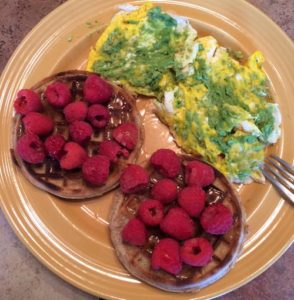
Waffles. Breakfast. Mmmm.
To live a well lifestyle, you need fuel, end of story. While running, cycling, or and working out in general isn’t an excuse to binge with reckless abandon, it’s important to have balance. Enjoy your favorite foods, eat them when you want. And do it unapologetically – like waffles. In the hospital. While recovering from the flu. Even when someone offers you chicken soup.
3. Leverage Connections – and Return the Favor
When Leslie attempted to revive the Harvest Festival, she needed a ton of support from the community. One of those groups, the local police department, was happy to help out, saying, “What Leslie Knope needs, Leslie Knope gets.” Clearly, she had a great relationship with the group.
Whether you need advice on meal prepping, support for your charity run event, or sometimes just a buddy to make you go to Friday a.m. cycling class, it’s important to have connections in the wellness arena. And be sure to lend your help to them just the same.
4. Celebrate Victories – Even the Little Ones
It would be hard to be friends with Leslie – not because she’s difficult, but because she’s THAT good of a friend. She remembers and marks every friendship milestone, even the smallest ones, and makes it a big occasion. To Leslie, everything is a reason to celebrate.
Don’t forget to celebrate your own little milestones in your ongoing wellness journey. Drink a gallon of water every day for a week – give yourself a high-five. Complete Day 1 of your Couch to 5k program – enjoy some R&R with Netflix.
5. It’s Okay to be Dramatic
“Everything hurts and I’m dying.” Famous words from Leslie. She has also been known to check – and double, and triple check – with others to make sure tasks and things are in order. Overkill? Maybe. Valid? Absolutely.

This has been me…many times
While I can’t speak for all athletes, runners, especially while tapering for a big race, can be a bit…okay, incredibly dramatic. For those of you who lift hard, swim hard, cycle hard, or meal prep hard, some days it can quite literally feel like everything hurts and you’re dying. And that’s okay. It may, but you’re not. You’re going to be okay.
Parks & Rec fans, are there other ways you can relate to Leslie on a health and wellness level? Comment or tweet me @LindsayIRL. Share photos and moments from your wellness journey on Instagram and Twitter using hasthtag #wellirl.
3 Reasons to Take a Rest Day
“I really regret that workout.”
You’ve probably read the above quote, followed by the words, “Said no one ever.” I left out those words on purpose. Because, let’s be real, I think most of us have had a workout that sucked so bad we wish it wouldn’t have happened. Whether it reminded me how tired and burned out I really was or it was so bad it even ruined the next day’s workout, there are plenty of workouts I’ve regretted.
A terrible workout can be rooted in many reasons. You had a bad day at work. You didn’t get good sleep the night – or several nights – before. Your mind is focused on a major issue with your partner or child. Or, one of the biggest and what I often find, a bad workout is a plea for a rest day.

Enjoying some R&R with my favorite lil guy.
Rest is crucial to every athlete’s workout regimen, whether the casual gym-goer or the hardcore professional. There’s now even a #restdaybrags phenomenon, with people sharing their rest day on social media instead of bragging about their workout.
National Relaxation Day is this week so it’s a great time for a reminder of why a rest day every week is important.
Your Body Needs It
You know how you’re not supposed to lift the same muscle groups two days in a row? It’s because those muscles need to rest in order to recover and grow.
The same is true for the rest of your body; you’re doing more harm than good by pushing it every day without allowing adequate time to recover.
Your Mind Needs It
Workout burnout is a real thing. Even the most enthusiastic gym rat can fall into a rut with a day-in, day-out, over and over again workout mentality. Like other muscles in your body, your brain deserves a day off from counting reps, calculating splits, or thinking about what’s next in the circuit.
An added bonus, knowing a rest day is coming can help you keep pushing in the days leading up to it.
Your Tomorrow Self Needs It
I don’t know about you but after one day off from running or the gym, I’m eager to get back at it. There’s something about taking a day away that allows the recharge needed to come back strong and with energy. Especially if you’re one who dwells on a bad workout and it gets in the way of the next day’s, the rest day really proves its worth, not the day you take it, the next day.
Take too long to give yourself that opportunity to step away from workout-mode, and you might find the next day at the gym is harder. The day after that, even worse. It’s a pattern that can lead to major burnout and forgoing workouts for a timeframe TBD – a pattern none of us want to fall into.
Do you take a rest day every week? Is it planned or do you listen to your body and use that as the guide for when it’s time to take a day off? Comment or tweet me, @LindsayIRL. Share your rest day pics on Twitter and Instagram too, and be sure to use hashtag #wellirl along with #restdaybrags.
Training For a Fall Marathon is Hard. Really Hard.
“There’s a first time for everything”
I’m no stranger to marathons. With nine under my belt, I’ve experienced a lot, both during training and on race day. But one thing I’ve never experienced until now is a whole new beast: marathon training in the summer.

Winter marathon training – what I know best
Of those nine full marathons I’ve run, all have been in the spring, either April or May. Because of this timing, I’ve only ever trained for marathons in the late winter/early spring. And, as someone who would take zero degrees, clouds, even snow over 75 degrees and sun ANY day, it has been great.
This fall I have, not one, but two full marathons on my schedule: Dick Beardsley on September 9, and Chicago on October 8. I’m hoping to be on the pace team for September’s race and I’m super-excited to be running October’s with my oldest bro; his first full marathon.
With each being exciting for its own reason, my enthusiasm to train is certainly there. I knew early on I’d need to make some adjustments to my training plan to accommodate summer life vs. winter life and that part has gone well. In fact, I’ve enjoyed the shift to more early morning runs. There was even one Friday I got up at 4:15 to knock out my long run – 12 miles – before work – and it wasn’t bad!
But, as someone who would take zero degrees over 75, I’m realizing that aspect makes training for a marathon in the summer hard. In fact, it’s really, really hard. In addition to acclimating my body to running earlier, both for shorter, weekly runs, and my weekly long run, I’ve made a few other adjustments.

Summer marathon training – a whole new game
First, I’ve said goodbye to shyness and braved the shirtless run numerous times. It’s amazing what consistent running in 70-plus degrees and sun can do to a person. Zero fucks are given anymore.
Next, I’ve experimented with a new fueling strategy. Normally, if I’m running 10 or more miles, I would eat a light breakfast and drink coffee beforehand to ensure I had enough gas in the tank to endure the long run. Getting out the door in the 5 a.m. hour doesn’t allow much flex to eat beforehand so I’ve been making it work, successfully running more than half marathon distance on a single Clif block alone.
Finally, water has been crucial – both to drink and to dump all over myself. I’ve started to more strategically plan my routes to have optional water access points along the way, such as supermarkets and gas stations. I’ve also learned that I need to add plenty of ice to my water bottle to have a chance of making it 10 miles without the liquid becoming lukewarm.
It’s funny; people often gasp and are amazed when I tell them I train for marathons outdoors, in the middle of winter – cold, snow, and all. But I’ve gotta say, training for a marathon in the middle of summer – now that’s something impressive. Although I’ve struggled several times and my finish times likely won’t be nearly as strong as if I had cooler weather to work with, I’m grateful for this new experience. I’ve got my eye on the payoff: Getting to run, not one, but two full marathons during my absolute favorite running season. Even more reason to be excited for fall!
Anyone else training for a fall marathon? Which one? Do you have any good tips you could offer me? Comment or tweet me, @LindsayIRL. Share your training progress on Twitter and Instagram too using hashtag #wellirl.
